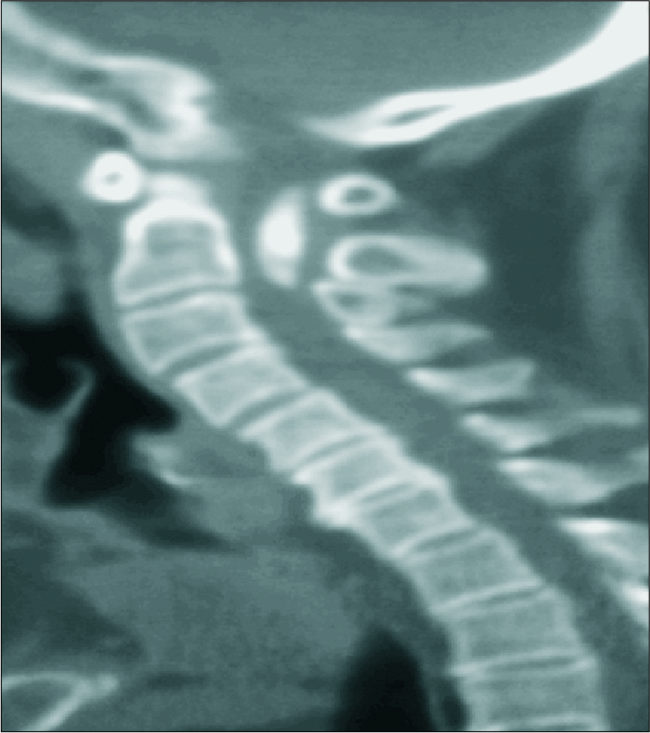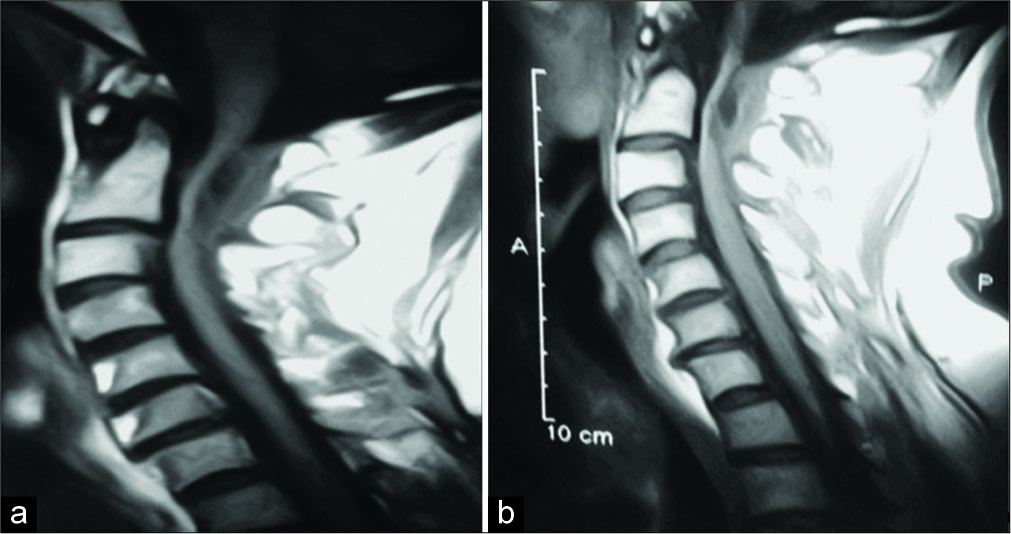- Stritch School of Medicine, Loyola University of Chicago, Maywood, Illinois, United States,
- Secondary School, Lahore Grammar School, Lahore, Punjab, Pakistan,
- Department of Neurosurgery, Nawaz Sharif Medical College, University of Gujrat, Gujrat, Punjab, Pakistan.
Correspondence Address:
Noama Iftekhar
Department of Neurosurgery, Nawaz Sharif Medical College, University of Gujrat, Gujrat, Punjab, Pakistan.
DOI:10.25259/SNI_605_2019
Copyright: © 2020 Surgical Neurology International This is an open-access article distributed under the terms of the Creative Commons Attribution-Non Commercial-Share Alike 4.0 License, which allows others to remix, tweak, and build upon the work non-commercially, as long as the author is credited and the new creations are licensed under the identical terms.How to cite this article: Noama Iftekhar, Abdullah Rasool, Irfan Khan. Cervical cord compression due to ossification of the ligamentum flavum – A case report and literature review. 06-Mar-2020;11:37
How to cite this URL: Noama Iftekhar, Abdullah Rasool, Irfan Khan. Cervical cord compression due to ossification of the ligamentum flavum – A case report and literature review. 06-Mar-2020;11:37. Available from: https://surgicalneurologyint.com/surgicalint-articles/9893/
Abstract
Background: Symptomatic compression of the cervical spinal cord by ossification of the ligamentum flavum (OLF) is rare. It typically involves the elderly and is particularly prominent in the Asian male population. Here, we present a 70-year-old Pakistani female who became quadriparetic due to OLF.
Case Description: A 70-year-old female became increasingly quadriparetic over 3 months duration, but exhibited preservation of vibration and proprioception. The cervical magnetic resonance/computed tomography revealed dorsal OLF measuring 7 mm × 25 mm × 14 mm. Two months following a decompressive laminectomy, her symptoms fully resolved.
Conclusion: Although rare in older patients, cervical OLF may contribute to significant cervical myelopathy characterized by a progressive quadriparesis that can be readily resolved with a decompressive laminectomy.
Keywords: Ligamentum flavum, Ossification of ligamentum flavum, Quadriparesis
INTRODUCTION
Ossification of the yellow ligament (OYL) (ossification of the ligamentum flavum [OLF]) most frequently occurs in the thoracic spine of elderly males of Asian descent.[
CASE REPORT
Presentation of spastic quadriparesis
A 70-year-old female presented with a progressive spastic cervical myelopathy/quadriparesis of over 3 months duration. She exhibited 4/5 strength in the right upper/right lower extremity, 3/5 strength in the left lower extremity, and bilateral Babinski responses without any sensory findings.
MR/CT findings
The CT scan directly confirmed hyperdense posterolateral ossification indicative of OYL measuring 25 mm × 14 mm × 7 mm [
Figure 1:
Cervical midline sagittal noncontrast two-dimensional computed tomography showed a dense ligamentous calcification central dorsally in the upper cervical canal contributing to marked canal narrowing 25 mm × 14 mm × 7 mm, and severe cord compression. Of interest was the clear separation of the ossification from the dorsal laminae of C1 and C2. This brings into consideration whether the ossification of the yellow ligament has penetrated the dura, as this image is similar to the double-layer sign seen in the subaxial spine.
Patient outcome
The patient underwent a decompressive C1-C2 cervical laminectomy. At surgery, OLF had to be carefully dissected away from the dura using an operating microscope; a cerebrospinal fluid (CSF) leak was averted. Eight days postoperatively, the patient exhibited significant improvement, and within 2 postoperative months, regained normal function.
DISCUSSION
Frequency of OLF
The prevalence of OLF varies from 3.8% to 26.0% and is mostly typically found in the thoracic spine of older men of East Asian descent.[
Pathology of OLF
The ligamentum flavum is composed primarily of elastic fibers. Overtime, and with continued mechanical stress, the normal fibrous tissue can become hypertrophied and become replaced by cartilaginous cells (e.g., chondrometaplasia). The deposition of calcium pyrophosphate dihydrate crystals further contributes to the formation of the OLF mass. OLF may be also linked to environmental comorbidities including obesity, diabetes, and a poor diet, while others invoke a genetic predisposition.[
Treatment of OLF
There are no current pharmacological treatments for cervical OLF.[
CONCLUSION
Although rare, ossification of ligamentum flavum should be kept on the differential when faced with symptoms of decreased strength and mobility, especially in the elderly population.
Declaration of patient consent
The authors certify that they have obtained all appropriate patient consent.
Financial support and sponsorship
Nil.
Conflicts of interest
There are no conflicts of interest.
References
1. Chachan S, Kasat NS, Keng PT. Cervical myelopathy secondary to combined ossification of ligamentum flavum and posterior longitudinal ligament-a case report. Int J Spine Surg. 2018. 12: 121-5
2. Christiano LD, Assina R, Goldstein IM. Ossification of the ligamentum flavum: A unique report of a Hispanic woman. Neurosurg Focus. 2011. 30: E15-
3. Geber J, Hammer N. Ossification of the ligamentum flavum in a nineteenth-century skeletal population sample from Ireland: Using bioarchaeology to reveal a neglected spine pathology. Sci Rep. 2018. 8: 9313-
4. Oh JY, Wang VT, Teo TW, Kaliya-Perumal AK, Hee HT. Ossification of the yellow ligament in the cervical spine -an unusual location. Biomedicine (Taipei). 2019. 9: 14-
5. Rahimizadeh A, Asgari N, Soufiani H, Rahimizadeh S. Ossification of the cervical ligamentum flavum and case report with myelopathy. Surg Neurol Int. 2018. 9: 263-
6. Song JY, Park JH, Roh SW. Ossified ligamentum flavum causing cervical myelopathy. Korean J Spine. 2012. 9: 24-7








